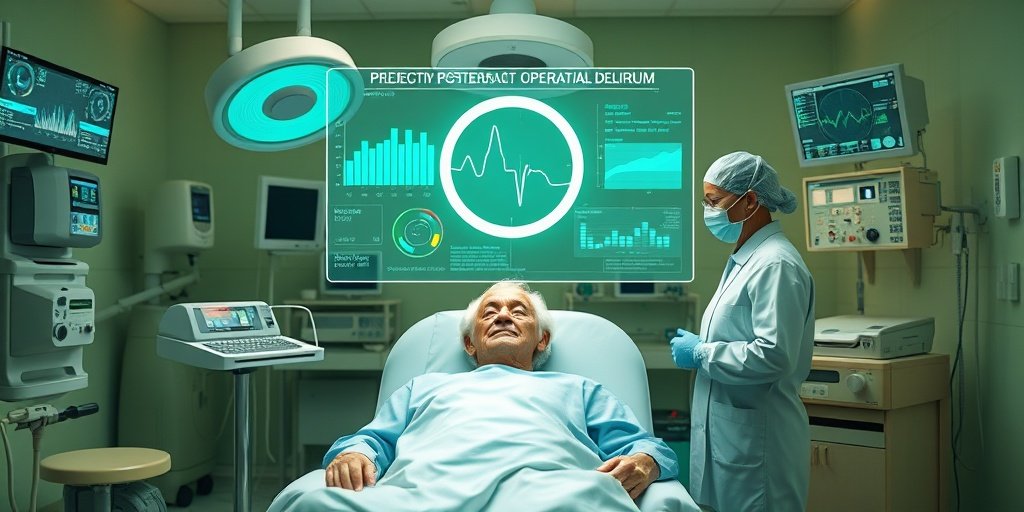⚡ Quick Summary
This study developed an XGBoost-based predictive model for postoperative delirium (POD) in elderly surgical patients, utilizing data from over 17,000 patients. The model achieved an impressive AUC of 0.85 and demonstrated high accuracy, highlighting the potential of machine learning in clinical risk assessment.
🔍 Key Details
- 📊 Dataset: 17,000 patients aged over 65 from the National Surgical Quality Improvement Program (NSQIP)
- 🧩 Features used: Patient demographics, comorbidities, surgical details, anesthesia type, and postoperative outcomes
- ⚙️ Technology: Machine learning techniques including Decision Trees, Random Forests, and XGBoost
- 🏆 Performance: Optimized XGBoost model achieved an AUC of 0.85, accuracy of 0.926, recall of 0.945, precision of 0.934, and F1-score of 0.939
🔑 Key Takeaways
- 📊 Postoperative delirium (POD) is a significant complication in older surgical patients, leading to increased morbidity and healthcare costs.
- 💡 Machine learning can enhance the prediction of POD, allowing for timely interventions.
- 👩🔬 The study utilized comprehensive perioperative data to develop a robust predictive model.
- 🏆 The XGBoost model outperformed other machine learning approaches in terms of predictive accuracy.
- 🌍 The findings suggest a need for integration of predictive models into clinical workflows for better patient management.
- 🔍 Future research should focus on external validation and practical implementation of the model.

📚 Background
Postoperative delirium (POD) is a common and serious complication among elderly patients undergoing surgery. It can lead to longer hospital stays, increased healthcare costs, and poorer patient outcomes. Accurate prediction of POD is crucial for implementing preventative strategies and improving overall patient care. With advancements in machine learning, there is a growing opportunity to leverage data for better clinical decision-making.
🗒️ Study
The study analyzed data from the National Surgical Quality Improvement Program (NSQIP), focusing on over 17,000 patients aged 65 and older who underwent various surgical procedures. Researchers aimed to develop a predictive model for POD using a range of machine learning techniques, including Decision Trees, Random Forests, and XGBoost. The study meticulously encoded categorical variables and standardized data to ensure accurate modeling.
📈 Results
The optimized XGBoost model emerged as the most effective, achieving an AUC of 0.85. Key hyperparameters included min_child_weight = 1, max_depth = 5, and gamma = 0.3. The model demonstrated an accuracy of 92.6%, with a recall of 94.5% and precision of 93.4%, indicating a well-balanced performance in predicting POD.
🌍 Impact and Implications
The implications of this study are significant for clinical practice. By utilizing a machine learning-based predictive model, healthcare providers can identify high-risk patients for POD more effectively. This proactive approach can lead to timely interventions, ultimately improving patient outcomes and reducing healthcare costs. The integration of such models into clinical workflows could revolutionize how we manage elderly surgical patients.
🔮 Conclusion
This study highlights the transformative potential of machine learning in predicting postoperative delirium among elderly patients. The development of a robust XGBoost-based model demonstrates how data-driven approaches can enhance clinical risk assessment. As we move forward, further research should focus on validating these findings and exploring practical applications in healthcare settings.
💬 Your comments
What are your thoughts on the use of machine learning for predicting postoperative complications? We would love to hear your insights! 💬 Share your comments below or connect with us on social media:
AI-delirium guard: Predictive modeling of postoperative delirium in elderly surgical patients.
Abstract
INTRODUCTION: In older patients, postoperative delirium (POD) is a major complication that can result in greater morbidity, longer hospital stays, and higher healthcare expenses. Accurate prediction models for POD can enhance patient outcomes by guiding preventative strategies. This study utilizes advanced machine learning techniques to develop a predictive model for POD using comprehensive perioperative data.
METHODS: We examined information from the National Surgical Quality Improvement Program (NSQIP), which included 17,000 patients who were over 65 and undergoing different types of surgery. The dataset included variables such as patient demographics (age, sex), comorbidities (diabetes, cardiovascular diseases, pre-existing dementia), surgical details (type, duration), anesthesia type and dosage, and postoperative outcomes. Categorical variables were encoded numerically, and data standardization was applied to ensure normal distribution. A range of machine learning approaches were assessed such as Decision Trees and Random Forests. Based on the greatest Area Under the Curve (AUC) from Receiver Operating Characteristic (ROC) analysis, the final model was chosen. Hyperparameter tuning was performed using GridSearchCV, optimizing parameters like max_depth, min_child_weight, and gamma for XGBoost model.
RESULTS: The optimized XGBoost model demonstrated superior performance, achieving an AUC of 0.85. Key hyperparameters included min_child_weight = 1, max_depth = 5, gamma = 0.3, subsample = 0.9, colsample_bytree = 0.7, reg_alpha = 0.0007, learning_rate = 0.14, and n_estimators = 123. The model exhibited an accuracy of 0.926, recall of 0.945, precision of 0.934, and an F1-score of 0.939, depicting a higher level of predictive accuracy & balance between sensitivity and specificity.
CONCLUSION: This study proposes a strong XGBoost-based model to predict POD in older surgical patients, demonstrating the potential of Machine Learning (ML) in clinical risk assessment. With the help of the model’s balanced performance indicators and high accuracy, physicians may identify high-risk patients and promptly execute interventions in clinical settings. Subsequent investigations ought to concentrate on integration into clinical workflows and external validation.
Author: [‘Boppana SH’, ‘Tyagi D’, ‘Komati S’, ‘Boppana SL’, ‘Raj R’, ‘Mintz CD’]
Journal: PLoS One
Citation: Boppana SH, et al. AI-delirium guard: Predictive modeling of postoperative delirium in elderly surgical patients. AI-delirium guard: Predictive modeling of postoperative delirium in elderly surgical patients. 2025; 20:e0322032. doi: 10.1371/journal.pone.0322032